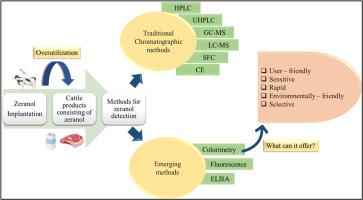动物产品中零醇检测的挑战和创新:基于比色法的传感器的作用是什么?回顾
引用次数: 0
摘要
Zeranol是一种具有雌激素活性的非甾体合成代谢剂。它在一些国家的牛肉工业中使用,以提高饲料效率和促进生长。然而,由于担心其对消费者的内分泌干扰作用,zeranol已在欧洲被禁止。在允许使用它的国家,已经实施了严格的法规来控制动物产品中的残留水平。尽管检测技术取得了重大进展,但对这些方法的最近一次全面审查是在17年前发表的,这突出表明需要更新这一领域的见解。这篇综述文章提供了一个最新的概述,用于确定zeranol及其代谢物在各种基质的方法。讨论了几种常用的色谱分析方法。此外,创新的方法,如酶联免疫吸附测定,荧光和比色法进行了检查。尽管分析仪器的成本很高,对技术人员的要求也很高,但这篇综述发现,它们仍然比较新的技术更受青睐。在新兴技术中,关于检测零醇的基于比色法的传感器的报道明显缺乏。因此,该方法在动物产品中zeranol检测中的应用尚不清楚,需要进一步探索以弥合知识差距。本文章由计算机程序翻译,如有差异,请以英文原文为准。

Challenges and innovations in zeranol detection in animal products: What role for the colorimetry-based sensors? A review
Zeranol is a non-steroidal anabolic agent with estrogenic activity. It is used in the beef industry in several countries to enhance feed efficiency and promote growth. However, due to concerns about its endocrine-disrupting effects on consumers, zeranol has been banned in Europe. In countries where its use is permitted, stringent regulations have been implemented to control residue levels in animal products. Despite significant advancements in detection techniques, the most recent comprehensive review of these methods was published 17 years ago, highlighting the need for updated insights in this area. This review article provides an up-to-date overview of the methods used to determine zeranol and its metabolites in various matrices. Some conventional chromatography-based methods are discussed. Furthermore, innovative methods such as enzyme-linked immunosorbent assay, fluorescence, and colorimetry are examined. Despite the high costs of analytical instruments and the requirement for skilled personnel, this review found that they are still favored over newer techniques. Among the emerging techniques, there is a notable scarcity of reports on colorimetry-based sensors for detecting zeranol. Accordingly, the application of this method for zeranol detection in animal products is poorly understood and in need of further exploration to bridge the knowledge gap.
求助全文
通过发布文献求助,成功后即可免费获取论文全文。
去求助
来源期刊

Food chemistry advances
Analytical Chemistry, Organic Chemistry, Chemistry (General), Molecular Biology
CiteScore
1.90
自引率
0.00%
发文量
0
审稿时长
99 days
 求助内容:
求助内容: 应助结果提醒方式:
应助结果提醒方式:


